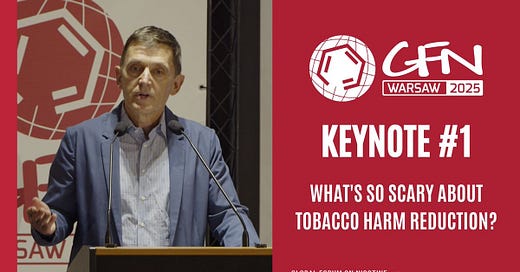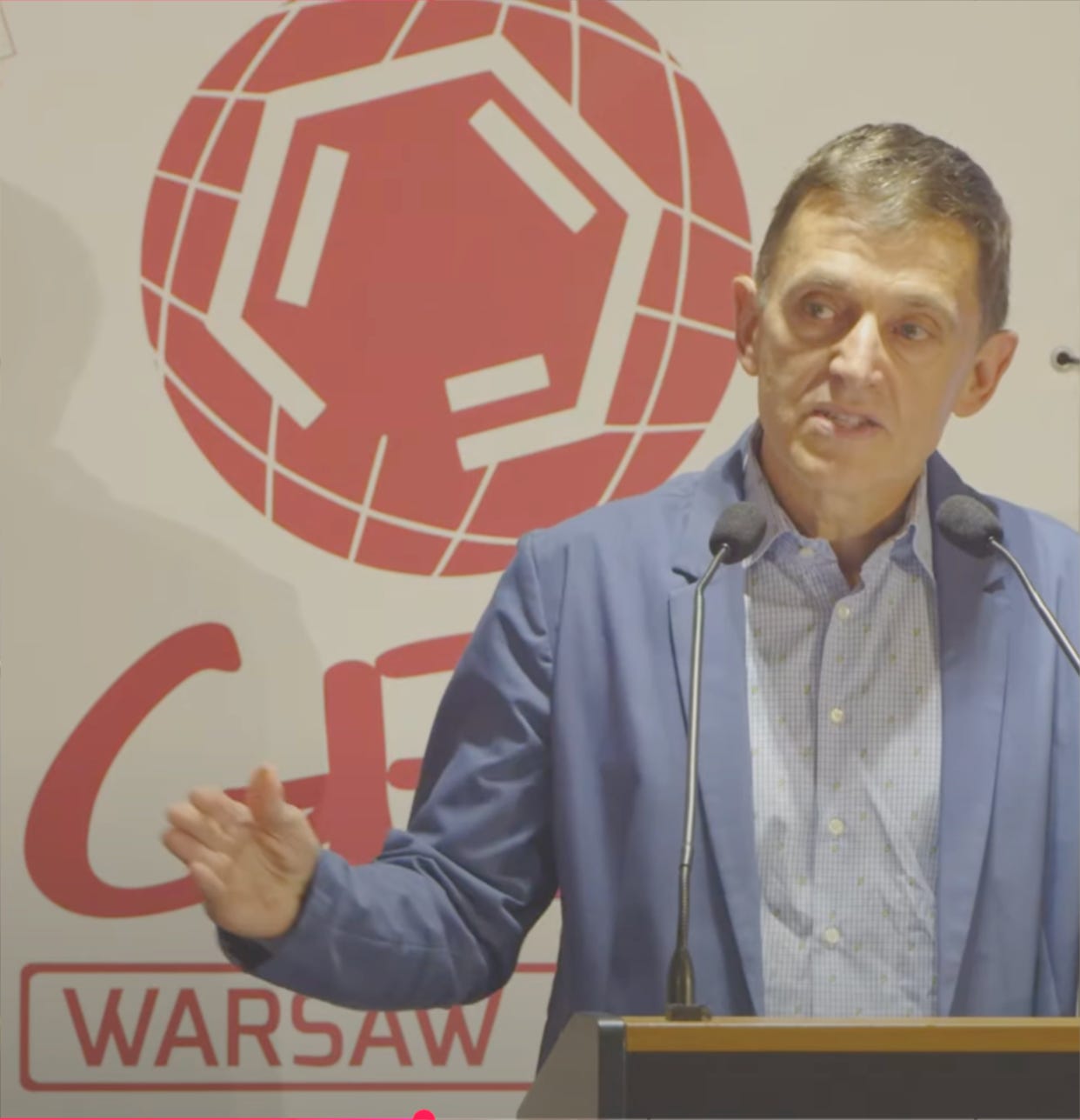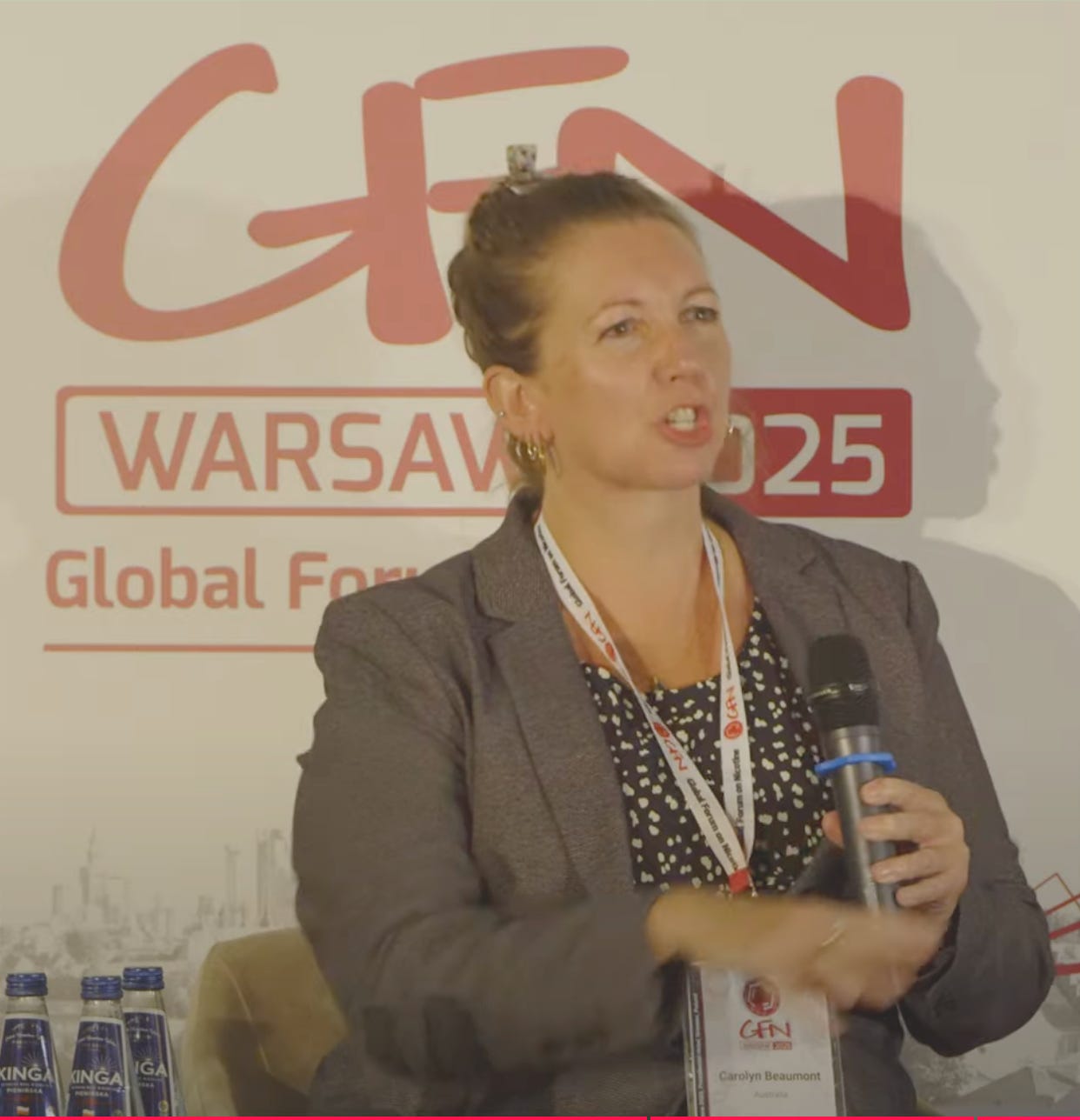When Tyndall and Beaumont Took the Stage
At the Global Forum on Nicotine 2025, two physicians denounce stigma, institutional inertia, and the vested interests delaying the transition to less harmful alternatives to smoking.
In the spacious ceremonial dimness of a conference hall in the heart of Warsaw, the air seemed suspended by a kind of electric expectancy.
LED lights reflected off rows of bowed heads: some gray, others covered by discreet veils in neutral tones, still others marked by partial baldness, low buns, or hastily tied ponytails held with utilitarian elastics. There were also young heads—not in aesthetic rebellion, but in functional cuts, natural tones, as if, within those walls, restraint carried more value than display. Eyes wandered between the stage, notebooks, and cell phone screens, in an attention divided, yet reverent.
The thick carpet muffled the final footsteps with the ceremonial gentleness of late arrivals. A nearly imperceptible scent of freshly arranged lilies mingled with the artificial sweetness of chewing gum and the lingering bitterness of lukewarm conference coffee. And still, there was silence. A dense, inhabited silence—not the absence of sound, but the presence of listening. The kind of silence that precedes either rupture or revelation.
Beneath a crimson banner with angular lettering — GFN Warsaw 2025: Global Forum on Nicotine — Paddy Costall, one of the event’s original architects, now in its twelfth edition, held the microphone with both hands, as if it were a candle in a stormy night. It was his task to open the first keynote of the forum, titled “What’s so scary about tobacco harm reduction?” — a question as provocative as it was necessary, especially in times when science is often hijacked by ideologies disguised as concern.
At his invitation, Dr. Mark Tyndall stepped onto the stage. He wore a light blue, almost grayish blazer, unbuttoned—like someone who favors freedom of movement over ceremonial constraint—and beneath it, a discreetly patterned shirt, buttoned to the top. No tie, as if to say that when the message burns, no ornament is needed. His short, well-trimmed hair revealed temples already claimed by time, though his eyes retained a kind of alert youthfulness. The skin on his face, exposed and unguarded, bore more the imprint of experience than of vanity. His hands—those of a doctor long accustomed to fevered bodies, syringes, scalpels, and the weight of other people’s stories—rested on the lectern with the steadiness of someone who has learned to hold tremors greater than his own. They no longer shook with nerves, but with memory: reverberating everything they had once touched—and all they were now about to reach through words.
His speech, modest at first, hinted at a deliberate displacement: he did not come from the field of tobacco control. And perhaps it was precisely because of that that he dared to be there. His presence served as a quiet reminder that sometimes it takes an outsider to see what insiders have long normalized—or no longer wish to see.
Later, the response to his intervention would come from Australian physician Carolyn Beaumont, who, through her own clinical experience, would complete the unsettling mosaic that the opening question — “What’s so scary about tobacco harm reduction?” — had begun to unveil.
The Smell of Africa, the Sound of Vancouver
Tyndall took us back to 1989, when he first stepped onto the deep brown soil of Nairobi, accompanied by his wife and two small children, immersed in a medical mission that would carry him to the very heart of the HIV epidemic in Africa.
In the late 1980s, the outskirts of Nairobi were likely more than just the city’s margins: they were transitional zones, caught between the promises of postcolonial modernity and the enduring legacy of inequality. Incomplete urbanization, dirt roads, intermittent electricity, and water as a precarious luxury. It was there, in a clinic built of concrete blocks and open window frames, that the doctor learned what he would never forget: to save someone requires accepting where that person stands. You don’t transform a body by imposing purity on it, but by offering dignity.
In the clinics, lines stretched for hours, young people and adults pointing to their lower abdomen in a silent, anxious plea. Infections were diagnosed by smell, by the way a person walked, and by the texture of their skin. And at the center of all that pain, the fear of HIV loomed like an unspeakable shadow.
More than antibiotics, what he offered was a steadfast gaze—eye to eye—and a quiet promise of containment: small rubber circles, handed out with the authority of someone who understood that, in that minimal material form, lay the power to interrupt a tragedy.
Later, in Vancouver—where the cold tore at the skin and alleyways exhaled a mix of urine, blood, and despair—the scene repeated itself with a different frame. This time, it wasn’t sex but syringes that carried the virus. And once again, the response was both simple and revolutionary: clean needles, safe places to inject, centers that allowed, if only for a few minutes, dignity to breathe—between chemical drags, trembling arms, and furtive glances.
And when death began to circulate in the form of a white powder — fentanyl, silent and lethal — the response once again did not come as repression or retreat, but as a pragmatic and ethical boldness: automated machines, programmed to dispense pharmaceutical-grade opioids under biometric control, offering those who could no longer wait a less fatal alternative. It was not a heroic gesture, nor a technical novelty. It was, above all, an act of human clarity: in the face of a collapse as predictable as it is deadly, refusing a safer path would be the true scandal.
The Bitter Taste of Vapor
As he moved into the topic of vaping, Tyndall shattered any lingering expectation of neutrality. With a calm gravity, he compared the current resistance to e-cigarettes with the deliberate delay in distributing antiretrovirals in Africa during the 1990s. It was as if he were saying that, once again, we had the cure — but lacked the courage.
Unlike smoke, vapor doesn’t carry the scent of death. It holds something of an artificial childhood: the aroma of vanilla, of synthetic fruit, of candyfloss conjured in a lab. But it is precisely this lightness that stirs suspicion in societies that equate suffering with virtue. They prefer the visible vice of cigarettes to the possibility of a less cruel transition.
The estimate that vaping is significantly less harmful than traditional smoking hung in the air—an almost obvious, yet still radical, fact. The question, unspoken but carried in the weight of his gaze toward the audience and the cameras, was unmistakable: if we know something can save lives, why do we still deny it?
When the Doctor Is Also a Heretic
That was when Carolyn Beaumont, arriving from the vastness of Australia, took the floor with the composure of someone who carries fatigue, but not surrender. Her accounts did not come from urban centers, but from remote communities where dust and heat crush any lingering hope of regular access to healthcare. There, doctors are nomads, and patients smoke as they breathe — out of habit, boredom, or some form of quiet desperation.
In those brief yet essential encounters, she realized that smoking cessation would not come through reprimand, but through listening. When she offered regulated vapes — controlled products, gently flavored and accessible — what she was truly offering was a possible pause between addiction and that vast, flat abyss stretching across the plains.
She also denounced, with a touch of bitter irony, the absurdity of seeing vapers relegated to the same spaces as smokers — as if the very act of trying to quit were punished by forced proximity to the trigger. It was like asking a recovering alcoholic to sit in a bar to drink soda.
She is currently writing a book titled Unfiltered, a collection of interviews with physicians from various fields, including cardiology, vascular surgery, anesthesiology, neurosurgery, and oncology.
The Room, the Time, the Bodies
As the two physicians spoke, the hall absorbed them in an almost liturgical silence. Water bottles remained untouched. The faint scent of ornamental flowers in the corners contrasted with the weight of their stories. The stage arrangement — three chairs, three glasses of water, three bodies standing against indifference — resembled a kind of secular communion table.
In his closing remarks, Tyndall evoked the image of a patient who, after giving up hard drugs, was still struggling with cigarettes. When he handed him a vape, it wasn’t just an alternative — it was an act of rescue. In another clinic, he imagined, that same patient might have received only bronchodilators and the vague promise of an X-ray — a bureaucratic hope that arrives too late.
Between Ashes and Possibilities
There is something profoundly subversive in the idea that care can be simple and straightforward. That it might come in a metallic casing, tasting of strawberry, of mint, of beginning again. But that simplicity—like almost everything that touches the margins—tends to unsettle.
What that audience—already largely convinced—received was not merely a conference. It was a gesture of lucid insubordination, woven in a calm, quiet voice, yet with the firmness of those who have seen too much to remain silent. It wasn’t specifically a call for rebellion, but a summons to conscience: for doctors no longer content to treat symptoms without confronting causes; for politicians able to recognize when the rules serve systems more than lives; for citizens willing to hear what prejudice so often drowns out.
Tyndall reminded the audience that the history of harm reduction has always been controversial, not because its strategies are weak, but because the bodies it aims to protect are the very ones the system is most willing to discard. And when those bodies smoke, use drugs, fall ill, or resist, they become easier to blame than to care for. It is far simpler to stigmatize them than to confront the structural inequality that shapes their suffering.
Dr. Mark Tyndall also made it clear: we have built a vast and profitable medical infrastructure around treating tobacco-related diseases — cardiologists, oncologists, pulmonologists — and no one seems in a hurry to dismantle it. Nor do tobacco control organizations, bound for decades to abstinence-only programs, show much willingness to reconsider their premises. Even the tobacco industry itself, despite showcasing sleek new products and smoke-free promises, prefers to watch the transition from a distance, with calculated slowness, as if avoiding leadership were a way of avoiding responsibility.
Alongside Tyndall, Carolyn Beaumont denounced the same inertia from a different angle: the apathy of both the public and policymakers toward smokers who no longer want to — or can’t — quit. And stigma, that invisible weight placed on those who still smoke or seek alternatives, doesn’t just marginalize: it punishes. And in punishing, it deepens surrender.
With every drag that goes unprevented — out of greed, dogma, apathy, or institutional convenience — a body dims a little more, silently and predictably, as part of an everyday necropolitics that decides who gets to live and who is left to die.
But there, at the center of that stage, two physicians — with experienced hands and even more awakened eyes — dared to remind us that medicine, when practiced with courage, is more than applied science: it is confrontation. A confrontation with inequality as a persistent determinant of disease, with marginalization as state policy, with indifference as public health doctrine.
They reminded us that smoking is not merely an individual choice, but also the outcome of colonial histories, psychic wounds, institutional absences, and economic structures that profit from human fragility. And that to fight this demands breaking the tacit pact between science and system — the pact that normalizes exclusion, sanitizes suffering, and turns health into privilege.
In refusing to accept that some bodies are disposable, Tyndall and Beaumont did more than defend harm reduction. They called for — with both serenity and force, far from any demagogic comfort — a medicine that rediscovers its public essence and its radical commitment to human rights. A medicine unafraid to get its hands dirty. One that listens before it judges. And one that, rather than merely reproducing the system, dares to heal the very world that produces it.





